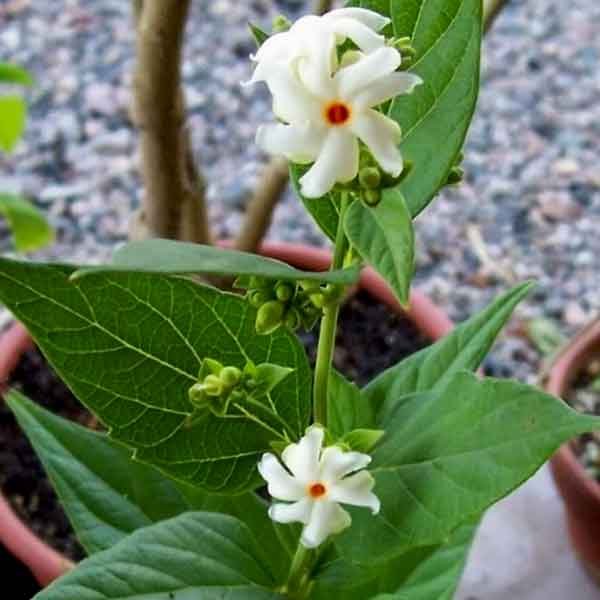Description
The Parijat Plant: A Sacred Marvel of Nature
The Parijat plant, scientifically known as Nyctanthes arbor-tristis, is a small flowering tree or shrub widely recognized for its cultural, medicinal, and ornamental significance in South Asia. Often referred to as the “Night-flowering Jasmine” or the “Tree of Sorrow,” this plant holds a special place in the hearts of nature lovers, traditional healers, and devotees alike. Its unique characteristics, fragrant blooms, and mythological ties make it one of the most enchanting plants in the botanical world.
Botanical Characteristics
The Parijat plant is a hardy shrub or small tree that typically grows up to 10 meters tall. Native to the Indian subcontinent and Southeast Asia, it flourishes in tropical and subtropical climates. The bark of the plant is grey and rough, and its branches are spreading with broad, ovate leaves that are rough to the touch.
The most captivating feature of the Parijat plant is its fragrant flowers, which bloom at night and fall to the ground by morning. Each flower has a small, bright orange tube with white, star-like petals. These flowers do not stay long on the tree, but rather form a beautiful carpet underneath it by dawn, adding to the poetic charm of the plant. Despite its common name, Parijat is not a true jasmine but belongs to the family Oleaceae.
Mythological and Cultural Significance
The Parijat plant is deeply embedded in Indian mythology and folklore. According to Hindu legends, it is believed that the Parijat tree originated from the churning of the ocean (Samudra Manthan) by the gods and demons. This celestial event gave rise to several divine items, including the Parijat flower, which was taken to the heavens.
Another popular story associates the plant with Lord Krishna. It is said that Krishna brought the Parijat tree from Indra’s paradise to please his wife Satyabhama. However, his other wife Rukmini loved the flowers dearly, leading to a tale of rivalry and devotion. Because of such mythological associations, the Parijat tree is often considered sacred and is grown near temples or in household courtyards.
In many Indian traditions, the flowers are used in pujas (religious offerings) and rituals. Despite being fallen flowers, Parijat blooms are permitted in worship, a rarity in Hindu practices. This exception underscores their perceived purity and divine origin.
Medicinal Uses and Ayurvedic Importance
The Parijat plant has been extensively used in Ayurveda and traditional medicine due to its numerous health benefits. Every part of the plant—leaves, flowers, seeds, bark—has therapeutic properties:
- Leaves: Known for their bitter taste, the leaves are used to treat fevers, especially malarial and dengue fever, as they help reduce body temperature. The juice of the leaves is often consumed with honey or water to treat cough, cold, and respiratory issues. They are also known to have anti-inflammatory and analgesic properties.
- Flowers: The fragrant flowers are rich in antioxidants and are believed to help in managing diabetes. They are also used to prepare herbal teas, known for their calming and digestive benefits.
- Seeds and Bark: The seeds have purgative properties, while the bark is used in treatments for rheumatism and joint pains.
Scientific studies support the antibacterial, antiviral, antifungal, and anti-inflammatory properties of the Parijat plant, making it a valuable herb in holistic medicine.
Ecological and Aesthetic Value
Apart from its religious and medicinal significance, the Parijat plant is admired for its aesthetic beauty. It is commonly planted in gardens, parks, and near homes due to its beautiful appearance and sweet fragrance. The tree attracts a wide range of pollinators, including bees and butterflies, supporting the local ecosystem.
The fallen flowers beneath the tree create a picturesque scene, making it a favorite among landscape designers. Its ability to bloom at night adds a unique charm, offering serenity and visual pleasure during twilight and dawn hours.
Symbolism and Literary References
The Parijat flower symbolizes love, separation, and longing, themes that are commonly reflected in classical Indian poetry and songs. The flower’s fleeting life—blooming at night and falling by morning—represents the transient nature of beauty and life, which has inspired poets for centuries.
In Sanskrit literature and Indian epics, the Parijat is often portrayed as a flower of immortality and divinity. Rabindranath Tagore, the famous Bengali poet, also referenced the plant in his works, emphasizing its spiritual and emotional depth.
Cultivation and Care
The Parijat plant is relatively easy to grow and maintain, making it a favorite among home gardeners. Here are some basic requirements for its cultivation:
- Climate: Prefers warm, tropical to subtropical climates. It does not tolerate frost well.
- Soil: Grows best in well-drained, loamy soil with moderate organic matter.
- Watering: Requires regular watering during the growing season but should not be overwatered.
- Sunlight: Thrives in full sun to partial shade.
- Pruning: Occasional pruning helps maintain its shape and encourages new growth.
Propagation is usually done via seeds or cuttings. It flowers mainly during late summer to winter, although in some regions, it can bloom multiple times a year.
Environmental and Cultural Conservation
In recent years, due to urbanization and deforestation, traditional plants like Parijat have seen a decline in some areas. Efforts are being made by environmental groups and botanical gardens to preserve this species due to its ethnobotanical value and cultural heritage. Schools and public institutions are increasingly using native trees like Parijat in awareness campaigns and eco-education.
In addition, the Parijat tree located in Kintoor village, Uttar Pradesh, is believed to be the only one of its kind that has mythological origins directly associated with the Mahabharata. This ancient tree has become a pilgrimage site, attracting thousands of visitors who believe in its divine powers.
Conclusion
The Parijat plant is more than just a flowering tree—it is a living embodiment of spiritual symbolism, traditional healing, ecological balance, and aesthetic splendor. Its divine associations, healing potential, and poetic presence make it a revered and cherished species in the Indian subcontinent and beyond. Whether found blooming silently in a temple courtyard or lighting up a garden with its night-time fragrance, the Parijat continues to be a symbol of purity, beauty, and transcendence.
In a world increasingly detached from nature and tradition, the Parijat serves as a gentle reminder of the interconnectedness of culture, health, and the environment. Planting and preserving this sacred tree is not just an act of gardening, but a tribute to a rich heritage that honors the mystical beauty of the natural world.






 3 inch (8 cm) Handi Shape Round Ceramic Pots - Pack of 5
3 inch (8 cm) Handi Shape Round Ceramic Pots - Pack of 5  Pleasant Vinca Seeds Garden Kit - Corporate Gift (set of 30)
Pleasant Vinca Seeds Garden Kit - Corporate Gift (set of 30)  Elephant bush, Portulacaria afra, Jade plant (Green) - Succulent Plant
Elephant bush, Portulacaria afra, Jade plant (Green) - Succulent Plant  LEMON GRASS-PLANT
LEMON GRASS-PLANT 

Reviews
There are no reviews yet.